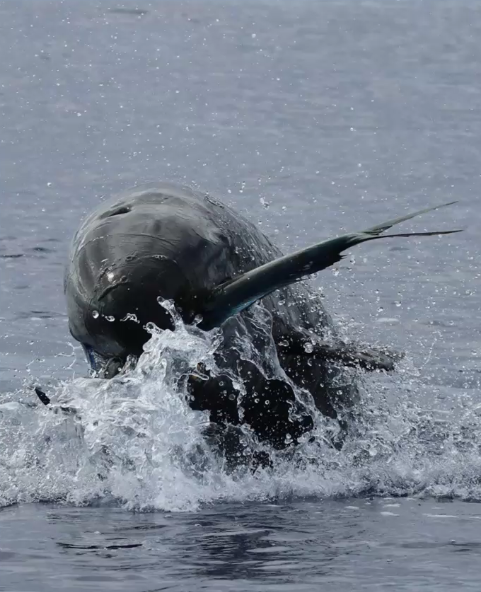
Recent reports by the Pacific Islands Fisheries Science Center (PIFSC) suggest that the pelagic population of false killer whales within the U.S. Exclusive Economic Zone (EEZ) around Hawai‘i may be larger than was previously thought.
Or it may be about the same.
It just depends on the analysis method being used.
Using the old “design-based” method, and data collected from ship surveys in 2017, PIFSC estimates there are 5,106 false killerwhales in the EEZ around Hawai‘i.
That method is “unbiased, but limiting,” Amanda Bradford, a researcher with the center, told the Western Pacific FisheryManagement Council at its meeting last month.
Results from a model-based method, which Bradford called “state of the art,” indicate that the population within the EEZ is almost the same size — between 2,100 and 2,200 whales — as was estimated in 2002 and 2010.
In the Central Pacific in general, however, the model-based method does indicate that the population in 2017 was larger than it was in 2012 and 2002. PIFSC estimated there were about 32,317 false killer whales in the region in 2017, compared to 24,000-25,000 in the earlier estimates.
Based on this new information, the council voted to ask the National Marine Fisheries Service to explore options for reopening waters south of the Main Hawaiian Islands that have been closed to longline fishing to protect the animals. The closed area, known as the Southern Exclusion Zone (SEZ), makes up a significant portion of the federal waters around the state.
The council recommended that “a simulation-based evaluation of the two estimators be undertaken to better determine the relative value of each approach for management decision making.” Even without the results of that evaluation, the council also recommended that NMFS use both the design- and model-based results to develop abundance estimates in the next stock assessment report for the whales.
Under NMFS’s take reduction plan for the whales, a closure of the SEZ is triggered when the deep-set longline fishery kills orseriously injures two pelagic false killer whales within the EEZ in a given year. Because the fishery has observers on just 20 percent of its vessels, NMFS interprets an observed death or serious injury of two whales to equal a take of 10 fleetwide.
“When the SEZ was implemented, the estimated population size of pelagic false killer whales allowed a maximum of nine individuals from the stock to be removed by means other than natural mortalities. Above that number could impair the stock’s ability to reach or maintain its optimum sustainable population, it was determined. The new estimates may indicate a need to modify that number,” a council press release issued last month states.
The SEZ closed last year for the second year in a row. NMFS is still reviewing all of the interactions in 2019 to determine whether or not to reopen the SEZ. Last year, there were 14 observed false killer whale interactions and one interaction with a whale that was not identified as a false killer whale, but was definitely one of the four species of black whales (also called blackfish) that live around Hawai‘i. The SEZ was closed in February after two takes in the EEZ. Four more were caught in the EEZ afterward, but only three were determined to have caused a death or serious injury. An additional eight whale interactions and one blackfish interaction occurred outside the EEZ. There were no interactions this year, as of press time.
Council member Mike Goto, who also runs the fish auction in Honolulu, seized on the estimates indicating a larger population.
“Obviously, we’re seeing abundance estimates going up. You know what our issue is with the SEZ. … How can we get this applied to our current situation?” He asked NMFS Pacific Islands Regional Office administrator Mike Tosatto.
Tosatto explained that the new information will get incorporated into the next stock assessment report, which will include a new estimate of how many whales the fishery can sustainably remove from the population, also known as the potential biological removal (PBR) level.
If, as a result of the new abundance estimates, the PBR grows so much that the population within the EEZ is no longer considered in need of special protection, Tosatto said that NMFS might “sort of walk away from a TRT [false killer whale take reduction team] wholly.” Short of that, things would remain much the same, but with a new PBR level and possibly new trigger for the SEZ closure, he said.
It’s unclear when that new stock assessment will be completed. Tosatto indicated that the new PIFSC estimates were still being reviewed, and the council’s own Scientific and Statistical Committee also needs to complete its review, as well.
— Teresa Dawson

Leave a Reply